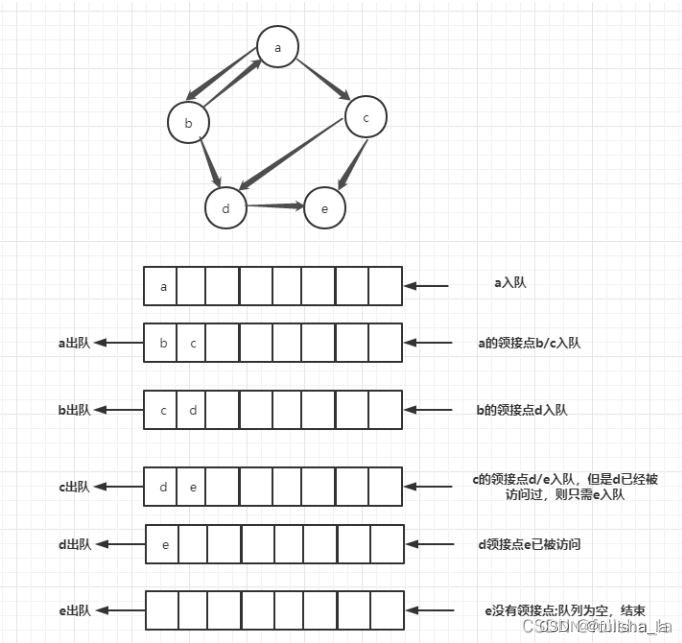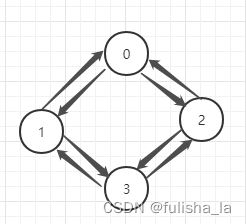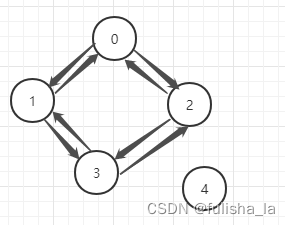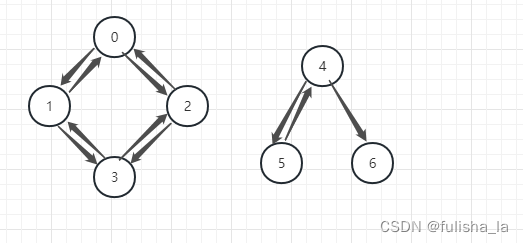说明
闵老师的文章链接: 日撸 Java 三百行(总述)_minfanphd的博客-CSDN博客
自己也把手敲的代码放在了github上维护:https://github.com/fulisha-ok/sampledata
day33 图的广度优先遍历
1.思路
结合下图,广度优先遍历假设从a节点出发,a访问后,访问领接点b/c,b访问了再访问c,又接着访问b的领接点,c的领接点,这样一层一层的访问,这就好比树的层次遍历一样。在访问图时要借助一个队列来实现.如图广度优先遍历的一种顺序是:a->b->c->d->e

根据上图,所结点所存储的矩阵值:
Δ
a
b
c
d
e
a
0
1
1
0
0
b
1
0
0
1
0
c
0
0
0
1
1
d
0
0
0
0
1
e
0
0
0
0
0
\begin{array}{c} % 总表格 \begin{array}{c|cccc} % 第二行 Delta 值数组 \Delta & a & b & c & d & e \\ \hline a & 0 & 1 & 1 & 0 & 0 \\ b & 1 & 0 & 0 & 1 & 0 \\ c & 0 & 0 & 0 & 1 & 1 \\ d & 0 & 0 & 0 & 0 & 1 \\ e & 0 & 0 & 0 & 0 & 0 \\ \end{array} % 第二行表格结束 \end{array} % 总表格结束
Δabcdea01000b10000c10000d01100e00110
通过上图的实现 可以知道,当我们出队一个结点,如a,就需要把a结点相应邻结点入队(这里我们采用的数据结构是矩阵,可以通过矩阵的行列值是否为1来判断是否与出结点是否相邻)则发现a行b列和a行c列是连接的,则说明b,c是a的领结点,则将b,c入队列。其他一样。
//代码中判断相邻结点
if (connectivityMatrix.getData()[tempIndex][i] == 0) {
//Not directly connected.
continue;
}
2.多个连通分量
在今天的文章中,这个遍历只能遍历只有一个连通分量的图(有向图),若有多个连通分量,则会漏一些节点数据(需要加一个循环来验证节点是否访问完)。在代码中有一个布尔类型数组:boolean[] tempVisitedArray = new boolean[tempNumNodes];若我们在一次广度遍历完遍历这个tempVisitedArray数组,再循环遍历是否有false,若有则说明图有多个连通分量,这是我们还需要把未遍历的节点再遍历完。
/**
* Judge connectivity
* @param tempVisitedArray
* @return
*/
public boolean isConnectivity(int paraStartIndex){
int tempNumNodes = connectivityMatrix.getRows();
breadthFirstTraversal(paraStartIndex);
for (int i = 0; i < tempNumNodes; i++){
if (!tempVisitedArray[i]){
breadthFirstTraversal(i);
return false;
}
}
return true;
}
3.代码实现
我在原来的基础上做了一些小的改动,来遍历所有的结点。加了一个方法isConnectivity, 来遍历所有的结点,将tempVisitedArray, resultString作为成员变量。
package graph;
import datastructure.queue.CircleObjectQueue;
import matrix.IntMatrix;
/**
* @author: fulisha
* @date: 2023/4/18 15:43
* @description:
*/
public class Graph {
IntMatrix connectivityMatrix;
/**
* The first constructor.
* @param paraNumNodes The number of nodes in the graph.
*/
public Graph(int paraNumNodes){
connectivityMatrix = new IntMatrix(paraNumNodes, paraNumNodes);
}
/**
* The second constructor.
* @param paraMatrix The data matrix.
*/
public Graph(int[][] paraMatrix){
connectivityMatrix = new IntMatrix(paraMatrix);
}
@Override
public String toString(){
return "This is the connectivity matrix of the graph.\r\n" + connectivityMatrix;
}
/**
* Get the connectivity of the graph.
* @return
*/
public boolean getConnectivity() throws Exception {
// Step 1. Initialize accumulated matrix.
IntMatrix tempConnectivityMatrix = IntMatrix.getIdentityMatrix(connectivityMatrix.getData().length);
//Step 2. Initialize
IntMatrix tempMultipliedMatrix = new IntMatrix(connectivityMatrix);
//Step 3. Determine the actual connectivity.
for (int i = 0; i < connectivityMatrix.getData().length - 1; i++){
// M_a = M_a + M^k
tempConnectivityMatrix.add(tempMultipliedMatrix);
// M^k
tempMultipliedMatrix = IntMatrix.multiply(tempMultipliedMatrix, connectivityMatrix);
}
// Step 4. Check the connectivity.
System.out.println("The connectivity matrix is: " + tempConnectivityMatrix);
int[][] tempData = tempConnectivityMatrix.getData();
for (int i = 0; i < tempData.length; i++) {
for (int j = 0; j < tempData.length; j++){
if (tempData[i][j] == 0){
System.out.println("Node " + i + " cannot reach " + j);
return false;
}
}
}
return true;
}
/**
* Unit test for getConnectivity.
*/
public static void getConnectivityTest(){
int[][] tempMatrix = { { 0, 1, 0 }, { 1, 0, 1 }, { 0, 1, 0 } };
Graph tempGraph2 = new Graph(tempMatrix);
System.out.println(tempGraph2);
boolean tempConnected = false;
try {
tempConnected = tempGraph2.getConnectivity();
} catch (Exception ee) {
System.out.println(ee.getMessage());
}
System.out.println("Is the graph connected? " + tempConnected);
//Test a directed graph. Remove one arc to form a directed graph.
tempGraph2.connectivityMatrix.setValue(1, 0, 0);
tempConnected = false;
try {
tempConnected = tempGraph2.getConnectivity();
} catch (Exception ee) {
System.out.println(ee);
}
System.out.println("Is the graph connected? " + tempConnected);
}
/**
* Breadth first Traversal
* @param paraStartIndex The start index.
* @return The sequence of the visit.
*/
boolean[] tempVisitedArray;
String resultString = "";
public String breadthFirstTraversal(int paraStartIndex) {
CircleObjectQueue tempQueue = new CircleObjectQueue();
int tempNumNodes = connectivityMatrix.getRows();
tempVisitedArray = new boolean[tempNumNodes];
// Initialize the queue
tempVisitedArray[paraStartIndex] = true;
resultString += paraStartIndex;
tempQueue.enqueue(paraStartIndex);
//Now visit the rest of the graph.
int tempIndex;
Integer tempInteger = (Integer) tempQueue.dequeue();
while (tempInteger != null){
tempIndex = tempInteger.intValue();
//Enqueue all its unvisited neighbors.
for (int i = 0; i < tempNumNodes; i++){
if (tempVisitedArray[i]){
// Already visited.
continue;
}
if (connectivityMatrix.getData()[tempIndex][i] == 0) {
//Not directly connected.
continue;
}
tempVisitedArray[i] = true;
resultString += i;
tempQueue.enqueue(i);
}
//Take out one from the head.
tempInteger = (Integer)tempQueue.dequeue();
}
return resultString;
}
/**
* Judge connectivity
* @param
* @return
*/
public boolean isConnectivity(int paraStartIndex){
int tempNumNodes = connectivityMatrix.getRows();
breadthFirstTraversal(paraStartIndex);
for (int i = 0; i < tempNumNodes; i++){
if (!tempVisitedArray[i]){
breadthFirstTraversal(i);
return false;
}
}
return true;
}
public static void breadthFirstTraversalTest() {
// Test an undirected graph.
//int[][] tempMatrix = { { 0, 1, 1, 0 }, { 1, 0, 0, 1 }, { 1, 0, 0, 1}, { 0, 1, 1, 0} };
//int[][] tempMatrix = { { 0, 1, 1, 0 , 0}, { 1, 0, 0, 1, 0 }, { 1, 0, 0, 1, 0}, { 0, 1, 1, 0, 0}, { 0, 0, 0, 0, 0} };
int[][] tempMatrix = { { 0, 1, 1, 0 , 0, 0, 0}, { 1, 0, 0, 1, 0, 0, 0 }, { 1, 0, 0, 1, 0, 0, 0}, { 0, 1, 1, 0, 0, 0, 0}, { 0, 0, 0, 0, 0, 1, 1}, { 0, 0, 0, 0, 1, 0, 0}, { 0, 0, 0, 0, 0, 0, 0} };
Graph tempGraph = new Graph(tempMatrix);
System.out.println(tempGraph);
String tempSequence = "";
try {
tempGraph.isConnectivity(2);
//tempSequence = tempGraph.breadthFirstTraversal(2);
} catch (Exception ee) {
System.out.println(ee.getMessage());
return;
}
System.out.println("The breadth first order of visit: " + tempGraph.resultString);
}
public static void main(String[] args) {
System.out.println("Hello!");
Graph tempGraph = new Graph(3);
System.out.println(tempGraph);
// Unit test.
getConnectivityTest();
breadthFirstTraversalTest();
}
}
- 单元测试1


- 单元测试2


- 单元测试3























 1378
1378











 被折叠的 条评论
为什么被折叠?
被折叠的 条评论
为什么被折叠?








